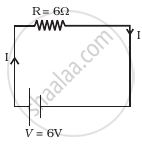Advertisements
Advertisements
Question
The drift velocity of electrons in a conductor connected to a battery is given by vd = `(−"eE" τ)/"m"`. Here, e is the charge of the electron, E is the electric field, τ is the average time between collisions and m is the mass of the electron.
Based on this, answer the following:
- How does the drift velocity change with a change in the potential difference across the conductor?
- A copper wire of length 'l' is connected to a source. If the copper wire is replaced by another copper wire of the same area of cross-section but of length '4l', how will the drift velocity change? Explain your answer.
Solution
- As the potential difference across the conductor is increased, the electric field set-up inside the conductor increases. Since vd ∝ E, drift velocity also increases with an increase in potential difference.
- Given vd ∝ E
but E = `"V"/"l"`
∴ `"v"_"d" ∝ (1/"l")`
As length increases to 4l, drift velocity becomes `(1/4)`th of the original value.
APPEARS IN
RELATED QUESTIONS
Define the term drift velocity.
Derive an expression for drift velocity of free electrons.
Estimate the average drift speed of conduction electrons in a copper wire of cross-sectional area 2.5 × 10−7 m2 carrying a current of 1.8 A. Assume the density of conduction electrons to be 9 × 1028 m−3.
The number density of free electrons in a copper conductor is 8.5 × 1028 m−3. How long does an electron take to drift from one end of a wire 3.0 m long to its other end? The area of cross-section of the wire is 2.0 × 10−6 m2 and it is carrying a current of 3.0 A.
Consider the following statements.
(A) Free-electron density is different in different metals.
(B) Free-electron density in a metal depends on temperature.
Peltier Effect is caused _______________ .
Consider the following statements.
(A) Free-electron density is different in different metals.
(B) Free-electron density in a metal depends on temperature.
Thomson Effect is caused _______________ .
Metals are good conductor of heat than insulator because
- Consider circuit in figure. How much energy is absorbed by electrons from the initial state of no current (ignore thermal motion) to the state of drift velocity?
- Electrons give up energy at the rate of RI2 per second to the thermal energy. What time scale would one associate with energy in problem (a)? n = no of electron/volume = 1029/m3, length of circuit = 10 cm, cross-section = A = (1mm)2

Explain how free electrons in a metal at constant temperature attain an average velocity under the action of an electric field. Hence, obtain an expression for it.
